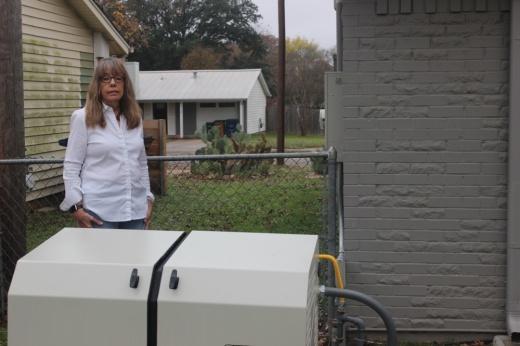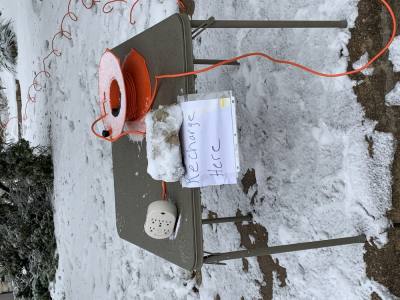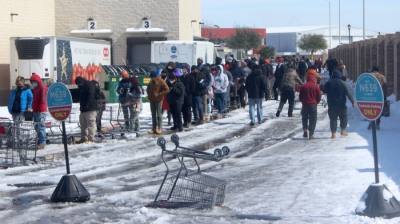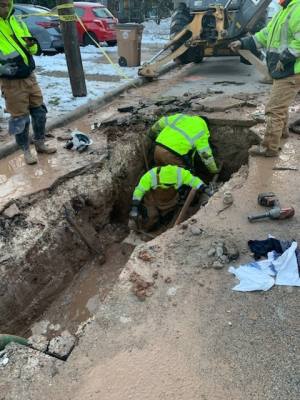Almost one year after deadly Winter Storm Uri caused Texas’ power grid to fail, leaving millions across the state without power or water, residents are taking emergency preparedness into their own hands.
For Lynn Wilson, surviving Uri meant braving temperatures below 20 degrees in her North Shoal Creek home with a compromised immune system, leaving her exhausted and causing her to lose weight.
“I literally froze to death for five days,” Wilson said. “It was so miserable ... I can’t see me weathering another five-day [freeze].”
More than 200 people in Texas died as a result of Winter Storm Uri, including 21 in Austin. The cold led to an unprecedented demand for electricity while it also damaged generator infrastructure.
A federal report and a city of Austin audit show that ahead of the storm, the state failed to heed concerns about the grid for years and the city failed to address known gaps in its emergency response.
These reports have laid out hundreds of changes that need to be made to prevent a similar crisis.
Many of the state and local changes will take months or years to implement.
“Ultimately, citizens and communities are going to have to pick up the slack or take responsibility for resilience,” said Fred McGhee, a Montopolis resident and president of its community development corporation.
Winter Storm Uri’s effects
East Austin resident Kristen Hotopp is one of 220,000 customers who were without power for days amid blackouts caused by “load shed” mandated by the Electric Reliability Council of Texas, or ERCOT.
“Somebody in my neighborhood died; an elderly person died,” Hotopp said. “I was afraid that I was going to have to go to a homeless shelter or something.”
Many residents were left without water for days and with damage due to burst pipes that would take months to repair. Austin Water reported it repaired 381 water lines, and completed 1,200 work orders and more than 1,500 emergency water shut-offs from Feb. 15-27.
“I’m deeply concerned because it’s a fact: We know if there is an extreme weather event that our city can’t handle it,” Southwest Austin resident Cynthia Wilcox said.
She worries about the city’s water infrastructure after last year’s freeze led to a water main break in her area.
Lisa McTiernan, an administrator with an East Austin property management company, also fears the upcoming winter. Last year, she tried to ensure faucets were dripping and the fire sprinklers were drained, but her preparations did not keep all the pipes from freezing.
“It’s hard because if we were just prepping for cold, then this would be great. But prepping for a blackout and subfreezing temperatures, we’re going to be in the same position again pretty much,” she said.
Prepping for the worst
Wilson, who endured below-freezing temperatures in her home, spent $9,000 on a new generator for her own peace of mind year-round and to provide a safety net for neighbors without a power backup.
“It seemed to be the only solution I could think of that would also cover me in the summertime if we lost our electricity then,” she said.
Hyde Park resident Hans Magnusson said he had to take the matter into his own hands to feel secure, given his view that the Texas Legislature failed to address state-level issues. He plans to buy a full home generator and prioritize home maintenance, such as water heater checkups.
“The next event can be worse,” he said.
Joe Rizzo, president of the Texas generator company Capital Power Systems, said his business quadrupled in Uri’s aftermath. Rizzo said generators can cost around $10,000 or more and may not be available for weeks or months.
Austin Energy also warned in September of permitting and installation delays amid “unprecedented” demand for whole-house generators.
“That storm [had] such an impact on Austin that it just hasn’t slowed down at all, and now it’s coming back, and it’s becoming more of an urgency for people to get power for their house,” Rizzo said.
Not all residents are dreading the coming season. In Southwest Austin, Jeff Bowen criticized the city for its “incompetent” storm response but said his standard seasonal preparations and supply will once again keep him afloat over the months ahead.
“We’re not really worried about anything coming up this winter; I just kind of look at it and go, ‘It is what it is,’” Bowen said.
ERCOT, the state’s electric grid manager, anticipates the grid can meet expected electricity needs during an average winter, but acknowledges that power loss is once again a possibility if temperatures fall and power generation drops. The prediction is similar to last year’s, when its warning that “extreme” conditions could spark widespread blackouts held true.
Winter watch
In November, Austin officials released a series of reports covering the city’s response to the emergency. Those reviews showed the city was unprepared across many areas, a fact that was frequently noted by those who struggled through the freeze.
“I didn’t see any help coming from the city of Austin to anybody that was stranded,” said Helen Rockenbaugh, a San Leanna resident who owns rental properties in Austin.
The city auditor’s office found that officials failed to adequately communicate with residents and that it struggled with exhausted personnel due to understaffing and the pandemic.
The city’s report found years of recommendations for improving Austin’s winter operations and disaster response had been ignored, sidelined or otherwise left incomplete.
“It’s extremely frustrating, and we need systems in place that don’t let that happen again,” District 10 Council Member Alison Alter said in November.
City leaders said they are now prioritizing emergency preparedness, but changes could take months or years.
“Preparing for disasters and emergencies begins at home. The individual preparedness approach helps build a more resilient community that is better prepared to handle crises of different kinds,” said Matt Lara, a spokesperson for the Austin Office of Homeland Security and Emergency Management.
ERCOT is moving ahead on its own 60-point plan to improve the state power grid’s reliability, and as of mid-October all but one of those items were listed as “on track” or completed. ERCOT did not respond to Community Impact Newspaper’s questions about its winter outlook and preparations as of press time.
For Hotopp, regardless of seasonal guidance or short-term fixes by the city and state, she said she remains “furious” with authorities' handling of the February disaster and aware of the limits that she and many of her neighbors still have to feeling truly secure.
“If you have the resources, it’s more so an inconvenience. The biggest problem will be any damage to your house, repairs needed,” she said. “If you’re lower on the resource ladder, it’s going to be survival.”








